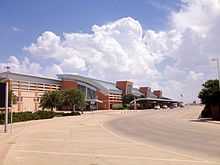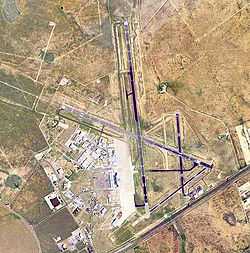Midland International Air and Space Port
| Midland International Air and Space Port | |||||||||||||||||||||||
|---|---|---|---|---|---|---|---|---|---|---|---|---|---|---|---|---|---|---|---|---|---|---|---|
|
2006 USGS airphoto | |||||||||||||||||||||||
| IATA: MAF – ICAO: KMAF – FAA LID: MAF | |||||||||||||||||||||||
| Summary | |||||||||||||||||||||||
| Airport type | Public | ||||||||||||||||||||||
| Operator | City of Midland | ||||||||||||||||||||||
| Serves | Midland and Odessa, Texas | ||||||||||||||||||||||
| Location | Midland County, between Midland and Odessa, Texas, USA | ||||||||||||||||||||||
| Elevation AMSL | 2,871 ft / 875 m | ||||||||||||||||||||||
| Coordinates | 31°56′33″N 102°12′07″W / 31.94250°N 102.20194°WCoordinates: 31°56′33″N 102°12′07″W / 31.94250°N 102.20194°W | ||||||||||||||||||||||
| Website | www.FlyMAF.com | ||||||||||||||||||||||
| Map | |||||||||||||||||||||||
 KMAF Location | |||||||||||||||||||||||
| Runways | |||||||||||||||||||||||
| |||||||||||||||||||||||
| Statistics (2007) | |||||||||||||||||||||||
| |||||||||||||||||||||||
Midland International Air and Space Port (IATA: MAF, ICAO: KMAF, FAA LID: MAF) (formerly Midland International Airport) is a city-owned international airport located approximately midway between the cities of Midland and Odessa, in the US state of Texas. It is owned and operated by the City of Midland. In September 2014 it became the first US facility licensed by the Federal Aviation Administration to serve both scheduled airline flights and commercial human spaceflight.[3]
Overview
Since 1991 it has been the headquarters of the Commemorative Air Force (CAF) and the American Airpower Heritage Museum. The airport has three airlines, two serving hubs with regional jets and one flying mainline jets. Southwest Airlines is the largest carrier at the airport. In 2012, 497,193[4] passengers were enplaned.
History
Origins
Midland International Air and Space Port started as Sloan Field, a small airport started in 1927 by Samuel Addison Sloan. Sloan leased 220 acres of flat grassland from Clarence Scharbauer, a rancher. Sam Sloan was killed in 1929 and his brother, William Harvey Sloan continued the operation. In 1939, Harvey Sloan sold the Field to the City of Midland for $14,500.
As war clouds gathered over Europe in the late 1930s, Midland businessmen could foresee the possibility of a military base in West Texas and in 1940 they started promoting the airport for use as a training base to the military establishment in Washington. Work was done by the Works Progress Administration with runway and taxiway improvements and lighting. Brigadier General G.C. Brant, Commander of the Gulf Coast Air Corps Training Center at Randolph Field visited and reported that the situation at Midland was favorable. On June 13, 1941 it was announced that Midland would become a training base, Midland Army Air Field
World War II
Midland Army Air Field was home to the Army Air Forces Bombardier School, one of a dozen bombardier-training schools. It was one of the "West Texas Bombardier Quadrangle" schools of the Army Air Forces Training Command. The other bases in the quad were Childress Army Airfield, San Angelo Army Airfield and Big Spring Army Airfield. The sole purpose of the Bombardier College was to train young men to use the bombsight invented by Carl Norden.
The first group of cadets, Class 42–6, arrived for training from Ellington, Texas, on February 6, 1942. Midland reached a peak base population of more than 4,000 and graduated a total of 6,627 bombardier officers by the conclusion of the training mission on January 1, 1946.
Postwar Civil use
Midland-Odessa Regional Airport (MAF) opened its new passenger terminal in the early 1960s. MAF was served by Continental and Trans-Texas (and American, until 1963); the first jets were Continental 707s in 1965.
The terminal had a scalloped roofline, allowing a column-free interior. All services - ticketing, baggage claim and concessions, were inside the building, and a single departure lounge opened onto the apron.
The late 1970s 'oil boom' led to economic growth in Midland-Odessa and many more flights by the incumbent airlines and new-entrants like Southwest Airlines. After airline deregulation in 1978, American and Delta began flights, followed by start-up America West Airlines in the early 1990s. A new gate area was built along the apron with four second-level gates with jetbridges, concession space and escalator wells linking the addition to the existing terminal. The south end of the main terminal was extended with more ticketing space and the original terminal was modernized (the scalloped roofline was removed).
By the 1990s several of the new-entrant carriers had pulled out and most of the remaining airlines had downgraded to regional jets. Only Southwest, the airport's largest carrier, operated mainline jet flights.
The terminal building looked tired, and airport officials began planning for a replacement. Construction began (in the infield parking lot) in 1996. The first half of the new terminal opened in early 1999, at which point the 1966 terminal was closed and demolished. The second half of the new terminal was finished in late 1999.
Until the September 11th attacks, everyone was allowed into the second floor; since then only passengers are allowed past the security checkpoints.
The first airplane built and flown in Texas, the "Pliska" (an approximate copy of the Wright Flyer II) was donated to the airport and is mounted in the passenger terminal over the baggage-claim area.[5]
In 2012 the Midland City Council amended a contract allowing three teams of experts, Midland International Airport, Parkhill, and Smith & Cooper, to prepare and submit a commercial space launch site application. On 17 September 2014, the FAA formally approved their application, making Midland International Airport the first primary commercial service airport to be certified as a spaceport.[6] The primary purpose of the launch site is to permit XCOR Aerospace to test their highly specialized reusable winged commercial space vehicle. XCOR Aerospace chose to relocate their headquarters[7] to the Midland International Airport which will soon be offering commercial space flights.[8] The XCOR research & development facility will be located at the airport as part of a $10 million economic development incentive deal.
Facilities

Midland International Air and Space Port covers 1,600 acres (650 ha) at an elevation of 2,871 feet (875 m). It has four runways:[2]
- 4/22 measuring: 4,605 x 75 ft (1,404 x 23 m) Asphalt
- 10/28: 8,302 x 150 ft (2,530 x 46 m) Asphalt
- 16L/34R: 4,339 x 100 ft (1,323 x 30 m) Asphalt
- 16R/34L: 9,501 x 150 ft (2,896 x 46 m) Asphalt
In the year ending February 29, 2008 the airport had 86,384 aircraft operations, average 237 per day: 39% military, 34% general aviation, 16% air taxi and 11% airline. 78 aircraft were then based at the airport: 39% single-engine, 47% multi-engine, 12% jet and 2% helicopter.[2]
Airlines and destinations
| Airlines | Destinations |
|---|---|
| American Eagle | Dallas/Fort Worth |
| Southwest Airlines | Dallas-Love, Houston-Hobby, Las Vegas |
| United Express | Denver, Houston-Intercontinental |
Top Destinations
| Rank | City | Passengers | Carriers |
|---|---|---|---|
| 1 | Dallas-Fort Worth, TX | 189,000 | American |
| 2 | Dallas-Love Field, TX | 92,000 | Southwest |
| 3 | Houston-Intercontinental, TX | 69,000 | United |
| 4 | Houston-Hobby, TX | 52,000 | Southwest |
| 5 | Las Vegas, NV | 27,000 | Southwest |
| 6 | Denver, CO | 1,000 | United |
References
- ↑ Midland International Airport, official site
- ↑ 2.0 2.1 2.2 FAA Airport Master Record for MAF (Form 5010 PDF), effective 2008-06-05
- ↑ Aviation Week & Space Technology, "Spaceflight Scheduling", 22 September 2014, p. 16
- ↑ http://www.faa.gov/airports/planning_capacity/passenger_allcargo_stats/passenger/media/PrelimCY12CommercialServiceEnplanements.pdf
- ↑ lymaf.com/pliska_aeroplane.aspx Midland International Airport website
- ↑ http://www.mrt.com/top_stories/article_216a60e0-3e73-11e4-ac49-9750fbe8fd3f.html
- ↑ http://www.xcor.com/press/2012/12-07-09_XCOR_to_open_midland_resaerch_headquarters.html
- ↑ http://www.rocketshiptours.com/
- ↑ http://www.transtats.bts.gov/airports.asp?pn=1&Airport=MAF&Airport_Name=Midland/Odessa,%20TX:%20Midland%20International&carrier=FACTS
External links
- Official website
- FAA Airport Diagram (PDF), effective April 30, 2015
- FAA Terminal Procedures for MAF, effective April 30, 2015
- Resources for this airport:
- AirNav airport information for KMAF
- ASN accident history for MAF
- FlightAware airport information and live flight tracker
- NOAA/NWS latest weather observations
- SkyVector aeronautical chart for KMAF
- FAA current MAF delay information
